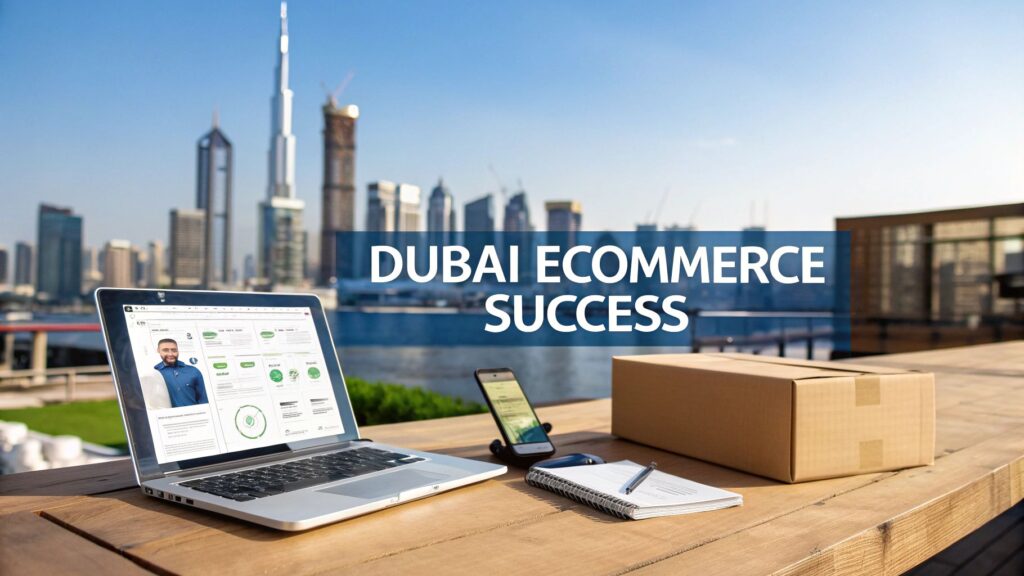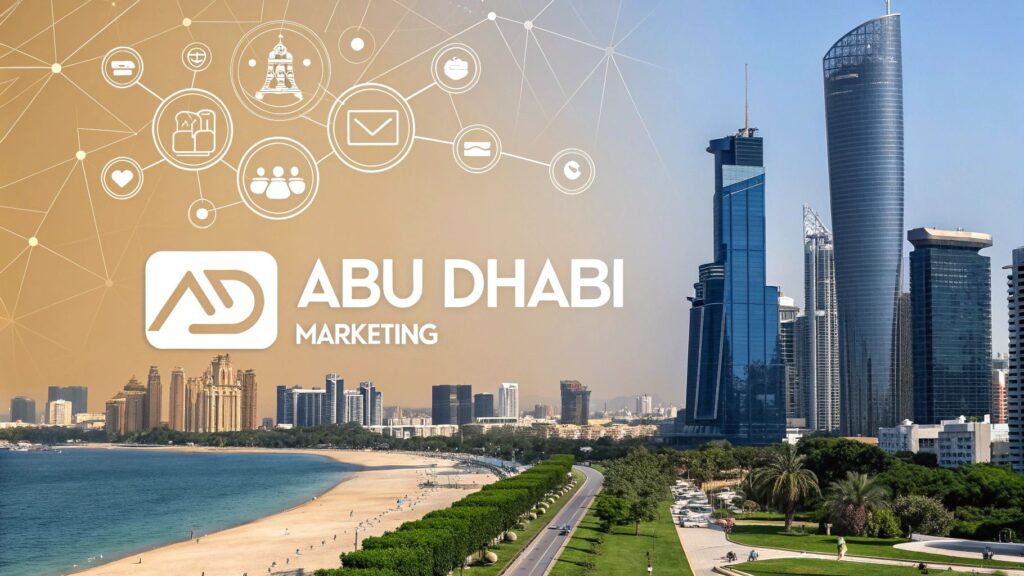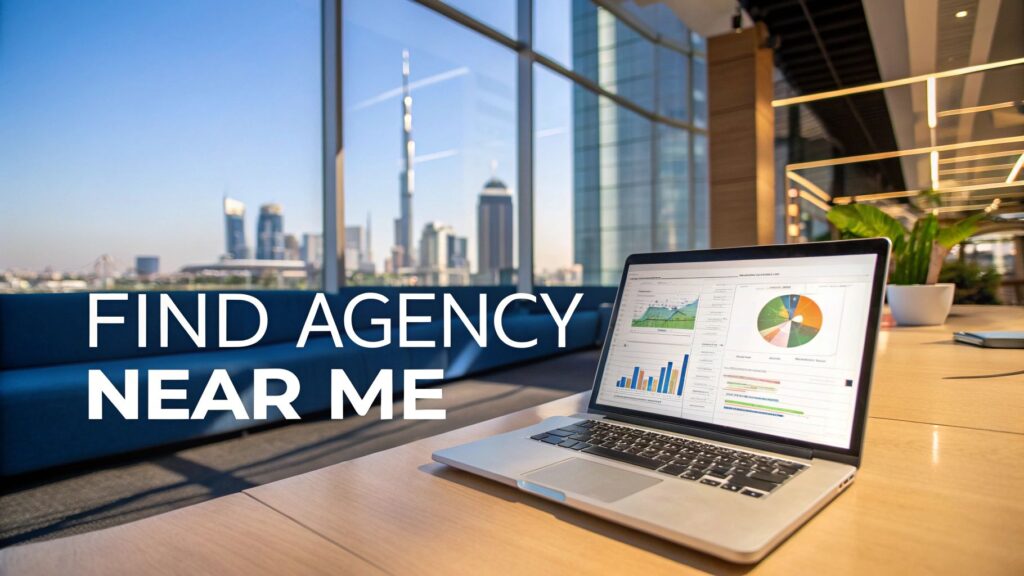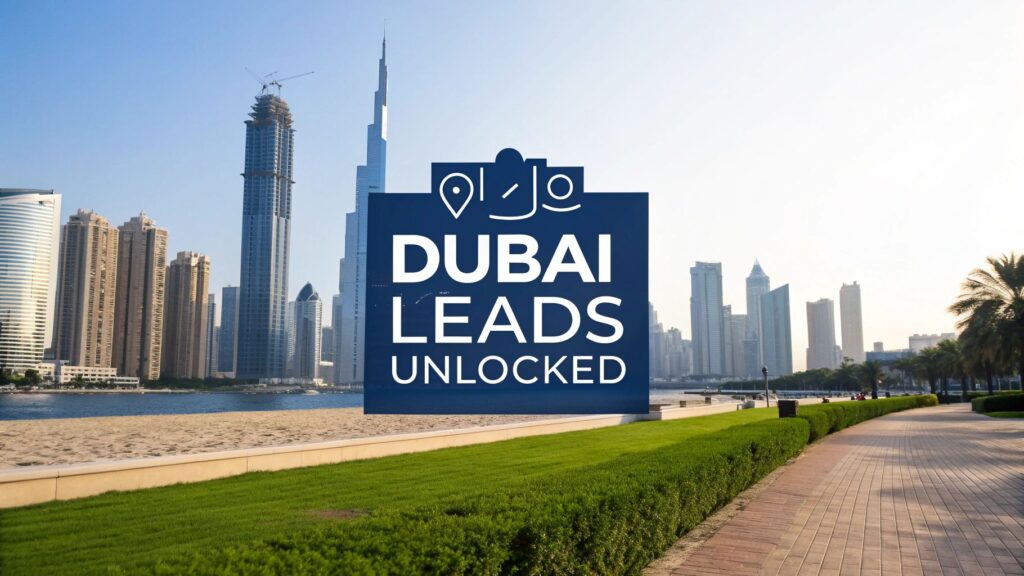A successful ecommerce website design in Dubai is built on far more than just a pretty homepage. It’s the result of a solid strategic foundation, one that’s grounded in a real understanding of the local market, your competition, and the technology that will power your business. Getting this initial planning phase right is what separates an online store that just exists from one that genuinely converts visitors into loyal customers.
Building Your Dubai Ecommerce Foundation
Before you even think about colours or fonts, you need to lay the strategic groundwork. This isn’t just a box-ticking exercise; it’s the most critical part of the entire project. Every decision that follows—from the user experience to your marketing campaigns—will flow from the clarity you establish here. Frankly, it’s the difference between launching a website and launching a successful online business.
This process rests on a few key pillars that, when combined, create a powerful plan for your digital storefront. Without this strategic thinking, even the most visually stunning site can miss its business goals entirely.
Understanding Your Audience and Competitors
First things first: who are you actually selling to? Dubai’s customer base is a unique melting pot with distinct preferences and online shopping habits. Are you targeting high-end luxury buyers, budget-conscious families, or young, tech-forward shoppers? The answer will dictate everything from your site’s layout and features to the languages you offer.
At the same time, you have to know who you’re up against. A deep dive into your competitors is non-negotiable. Pinpoint the leading e-commerce players in your niche here in Dubai and put their websites under the microscope.
- What makes them stand out? What’s their core promise to customers?
- How easy (or frustrating) is their checkout process?
- What kinds of deals and promotions are they running?
- Where are the gaps? Is there a weak spot in their customer experience you can swoop in and own?
This initial research phase is all about gathering intelligence to build a smarter strategy from day one.

As you can see, these three elements—your audience, the competition, and your technology—are the essential building blocks for the entire project.
Choosing the Right Ecommerce Platform
The technology you choose is the backbone of your online store. It dictates your site’s flexibility, how easily it can grow with you, and its potential for the future. The classic debate between platforms like Shopify or Magento (now Adobe Commerce) versus a custom solution comes down to your specific business needs. Shopify is fantastic for getting to market quickly and is incredibly user-friendly, whereas Magento offers deep customisation for larger, more complex operations.
Your e-commerce platform isn’t just a piece of software; it’s the engine of your online business. Making the right choice now supports future growth and keeps things running smoothly. The wrong one creates constant headaches and can lead to expensive migrations down the road.
The UAE’s e-commerce market is on a massive upward trajectory, projected to reach $17 billion by 2025. This explosive growth is fuelled by a digitally savvy population where over 80% of online shoppers make purchases using their smartphones. That single statistic tells you everything you need to know: a mobile-first design isn’t just a good idea, it’s essential. This should be a top consideration when you’re evaluating platforms.
Ultimately, this foundation is a mix of smart market insights and technical planning. Spending the time to get it right ensures your ecommerce website design in Dubai is built for long-term, sustainable success. If you’re weighing your options, learning more about professional ecommerce website services can offer some much-needed direction.
Designing for the Modern Dubai Shopper
A beautiful design is worthless if your customers can’t easily find what they want and complete a purchase. When it comes to a successful ecommerce website design Dubai project, creating a smooth, intuitive user experience (UX) is everything. You’re not just building a website; you’re crafting a digital storefront that feels welcoming and completely effortless for the sophisticated local consumer.
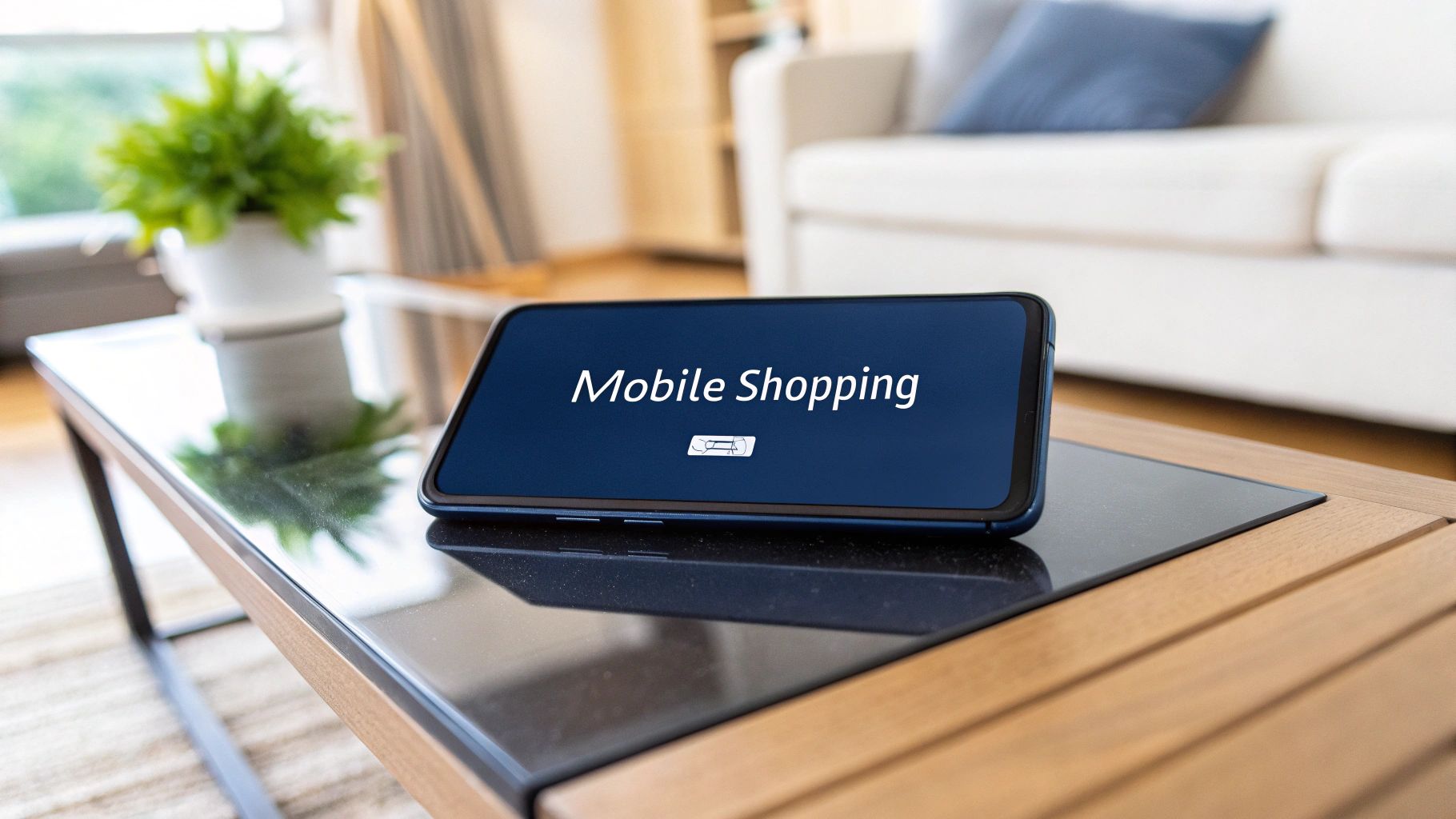
The golden rule? Always, always prioritise mobile users. A mobile-first approach isn’t just a good idea anymore—it’s essential for survival in the Dubai market. This means you design the entire customer experience for the smallest screen first, then scale it up for tablets and desktops.
This way, you ensure the core functions work perfectly for the vast majority of your audience, which naturally leads to a better user experience and, more importantly, higher sales.
Crafting an Intuitive User Journey
Think of seamless navigation as the backbone of your online store. Shoppers in Dubai have high expectations; they want a clean, uncluttered interface that gets them to their desired product without any fuss. This means:
- Clear, logical menus
- Well-organised product categories
- A prominent search bar that actually works
Your calls-to-action (CTAs) need to be just as sharp. Use direct, action-focused text like “Add to Cart” or “Buy Now.” Make these buttons pop with contrasting colours so they’re impossible to miss.
The real goal here is to remove every ounce of friction from the buying process. Every single click should feel natural and move the customer one step closer to checkout, never leaving them guessing what to do next.
High-quality product photography is also non-negotiable. Customers expect to see crisp, detailed images from multiple angles. The trick is to heavily optimise these images so they load almost instantly, even on a spotty mobile connection, otherwise, you risk visitors bouncing before they even see your products.
Mobile-First vs Responsive Design for Dubai Ecommerce
Choosing the right design philosophy is a critical first step. While both mobile-first and responsive design aim to provide a great experience on any device, they approach the problem from different angles. Given Dubai’s mobile-dominant user base, understanding the difference is key.
| Feature | Mobile-First Design | Responsive Design |
|---|---|---|
| Core Philosophy | Designs for the smallest screen first, then scales up. | Designs for desktop first, then scales down. |
| Performance | Generally faster on mobile as it loads only essential elements. | Can be slower on mobile as it often loads and then hides desktop-specific elements. |
| User Experience | Tends to be more focused and streamlined on mobile devices. | Can sometimes feel cluttered on mobile if not executed carefully. |
| Best For | Businesses where the vast majority of traffic (over 70%) is mobile. | Businesses with a more evenly split audience between desktop and mobile. |
| Development | Can be more complex initially but often leads to cleaner code. | A more traditional and widely understood approach. |
For most e-commerce businesses targeting the Dubai market, a mobile-first approach is the clear winner. It directly addresses the behaviour of the local audience, ensuring a fast, clean, and conversion-focused experience where it matters most.
Embracing Local and Cultural Nuances
Understanding the local culture is your shortcut to building trust. Dubai’s diverse market generally prefers minimalist, elegant designs that convey a sense of premium quality and reliability. Use plenty of white space to let your products stand out and stick to a clean, organised layout.
Most importantly, offering a fully bilingual experience is essential. Your website must have a seamless toggle between English and Arabic. This isn’t just about the homepage; every piece of text, from product descriptions to checkout instructions, needs to be professionally translated.
The quality of your design has a direct, measurable impact on customer behaviour. In a market where a massive 72% of internet traffic comes from mobile devices, a responsive and fast-loading site is your foundation for success. People form an opinion about your credibility in seconds, making visual appeal and a clear structure vital for building the trust that leads to sales.
Ultimately, a well-thought-out design balances universal usability with specific local expectations. For a deeper dive, check out our guide on creating a top-tier ecommerce website design in the UAE for more practical advice.
Integrating Essential Local Functionality
A great-looking ecommerce website design in Dubai is just the start. The real engine is what’s under the bonnet – the functionality built specifically for local shoppers. Getting these integrations right is what turns a pretty online catalogue into a sales machine that actually builds trust and converts in the UAE market.
This isn’t about using generic, off-the-shelf solutions. It’s about plugging into the specific platforms and features that Dubai customers recognise and expect. From the way they pay to how they get their hands on their order, every touchpoint has to feel local, familiar, and completely secure.
Seamless and Secure Local Payments
First things first: you have to make it dead simple for people to pay you. While international credit cards are widely used, you absolutely must integrate with trusted local payment gateways to build credibility. Names like Telr and PayFort (which is now Amazon Payment Services) are mainstays in the region.
When a customer sees these logos, it’s an instant signal that you’re a legitimate, established local business. They provide top-notch security and are built to handle AED transactions smoothly, which helps cut down on abandoned carts right at the final hurdle.
But here’s the thing – card payments are only half the picture.
Cash on Delivery (COD) is still incredibly popular across the UAE. If you don’t offer it, you’re instantly shutting the door on a huge chunk of your potential audience. For many, it’s a massive trust signal, letting them see and touch the product before parting with their cash.
Your payment setup needs to be rock-solid. Make sure it includes:
- Multiple Gateway Options: Give customers choices, like Telr, PayFort, or Checkout.com.
- A Clear COD Option: Don’t hide it. Make Cash on Delivery a prominent choice at checkout.
- Multi-Currency Display: Showing prices in both AED and USD is a smart move for catering to expats and international visitors.
Reliable Logistics and Shipping Integrations
The moment an order is confirmed, the customer’s next question is always, “When am I getting it?” A slick, predictable delivery experience is everything for keeping customers happy and getting them to come back. The best way to do this is by integrating your e-commerce platform directly with regional logistics powerhouses like Aramex or modern, tech-driven players like Fetchr.

These integrations completely automate your shipping workflow. An order comes in, and the system can instantly generate shipping labels, pull real-time shipping quotes, and send customers the tracking information they’re waiting for. It’s a huge time-saver for you, and it delivers the transparency shoppers now take for granted.
A direct Aramex API integration, for instance, lets your website:
- Instantly check and validate a customer’s address.
- Generate airway bills without any manual typing.
- Schedule a courier pickup right from your admin panel.
- Send live tracking updates to the customer by email or SMS.
This level of automation makes your entire post-purchase experience feel professional and dependable.
Building Trust Through Local Compliance
Finally, solid functionality goes beyond just payments and shipping. It’s also about playing by the local rules and earning customer trust. Your site must comply with UAE regulations, especially around data privacy. This means having a privacy policy that’s easy to find and understand, clearly explaining how you handle customer data.
On top of that, a crystal-clear returns policy is non-negotiable. Shoppers need to feel confident that they have options if a product isn’t what they expected. By displaying your returns and exchange process somewhere obvious, you remove one of the biggest anxieties people have about buying online. This combination—secure payments, reliable delivery, and transparent policies—is the true functional foundation of any successful Dubai e-commerce store.
Fine-Tuning for Speed and Search Visibility
In Dubai’s packed digital marketplace, a slow or invisible website is dead on arrival. Once your e-commerce site is live, its performance is everything. Your success really comes down to two things: how fast your pages load and how easily customers can find you on Google.

I always tell clients to think of a slow site like a shop with a sticky door. It’s frustrating. Most people will just turn around and leave. This isn’t just a poor customer experience; Google sees it as a major red flag and will penalise your search rankings for it.
Guaranteeing Lightning-Fast Load Times
In modern e-commerce, speed is not a feature—it’s a requirement. A delay of just a few seconds can send your bounce rate through the roof.
The first move is always to build on a solid foundation. That means choosing a regional web host with servers physically located in or near the UAE. This simple choice drastically cuts down on latency, which is the time it takes for your site’s data to reach a customer’s device.
After that, it’s all about keeping your site’s content lean and efficient. This isn’t a one-time fix but a series of ongoing tasks.
- Aggressive Image Compression: High-quality product photos are essential, but they are often the main culprit for slow pages. Use tools to shrink their file size without any noticeable drop in quality.
- Leverage Browser Caching: This is a clever trick that stores parts of your website—like your logo and style files—on a visitor’s device. When they come back, their browser doesn’t need to download everything all over again, making their next visit feel almost instant.
- Minify Your Code: Think of this as house-cleaning for your website’s code. It removes all the unnecessary characters and spaces from your HTML, CSS, and JavaScript files, making them lighter and faster for browsers to read.
Every millisecond you shave off your load time is a direct investment in a better user experience and stronger search performance. It pays dividends in customer retention and visibility.
Dominating Search with Local SEO
Speed gets people in the door, but SEO is what helps them find your door in the first place. This is where on-page Search Engine Optimisation (SEO) specifically for the Dubai market comes into play. It’s all about structuring your site and content so search engines know exactly what you sell and who you’re trying to sell it to.
Your whole strategy needs to revolve around what local customers are actually typing into Google. This means doing proper keyword research to find phrases like “buy electronics in Dubai” or “same-day gift delivery UAE.”
Once you know what people are searching for, you need to weave those terms naturally into your site:
- Compelling Product Titles and Descriptions: Always write for your human customers first, but be sure to include your target keywords. Critically, you need to offer these in both flawless English and Arabic to connect with the entire market.
- Logical URL Structures: Keep your URLs clean, short, and descriptive. For example,
yourstore.ae/mens-shoes/leather-loafersis much better than a string of numbers and codes. - Alt Text for Images: This is a simple description of your product images. It helps visually impaired users and gives search engines another clue about what’s on the page.
A solid SEO foundation makes sure that your beautiful, fast website actually gets the traffic it deserves. For any business that’s serious about ranking, getting a professional technical SEO setup can give you the expert configuration needed to get ahead of competitors from day one. When you combine raw speed with smart visibility tactics, you build a powerful engine for long-term growth.
How to Budget Your Dubai E-commerce Project
Getting a real handle on the investment your online store needs is the first, most critical step. I’ve seen it time and again: businesses underestimate the costs, and it forces them to cut corners on quality or essential features later on. A clear, honest budget for your e-commerce website design in Dubai isn’t just about planning; it’s about making sure every dirham you spend is pushing you towards long-term growth.
The final figure can swing wildly depending on your ambitions. The biggest fork in the road, and the one that will most heavily influence your budget, is whether you opt for a sleek template-based site or a completely custom-built platform. A template gets you selling fast. A custom build gives you unique functionality and the room to scale without limits.
Key Investment Areas to Consider
To avoid any nasty surprises down the line, it helps to break down your spending into distinct categories. This is about more than just the initial design fee; you need to think about the entire ecosystem required to keep your store running smoothly.
You’ll have a few non-negotiable line items right from the start:
- Domain Registration: This is your online address, like
yourbrand.ae. It’s a small but essential annual fee. - Secure Web Hosting: The server where your website’s files live. My advice? Choose a provider with servers close to or within the region for a noticeable speed boost.
- SSL Certificate: This is what puts the padlock icon in your customer’s browser, encrypting their data. In e-commerce, this is an absolute must-have for building trust.
- Platform and Development Costs: The main event. This covers the design, coding, and complete setup of your store.
These are just your foundational costs. The more complex your feature list gets, the more layers you’ll add to the budget, which is why a detailed plan is so crucial.
Factoring in Complexity and Ongoing Costs
The cost of building an e-commerce site in Dubai reflects both the huge opportunity and the unique demands of the market. The price can range significantly, depending on whether you need a basic setup, a custom design, or a highly responsive site built for the mobile-first habits of local shoppers. Key cost drivers always come down to development hours, design intricacy, SSL certification, and ongoing maintenance.
With the level of competition here, many businesses rightly set aside a healthy budget for platforms that offer secure, seamless payment gateways and intuitive interfaces—both are vital for earning customer trust and meeting the UAE’s high cybersecurity standards.
Remember, hitting ‘launch’ is the starting line, not the finish. Your budget absolutely must account for ongoing costs like maintenance, security patches, and future feature upgrades to stay competitive.
Think about it this way: integrating a sophisticated inventory management system or a bespoke customer loyalty programme is going to require more investment than a standard out-of-the-box setup. Likewise, many premium themes or plugins come with their own annual subscription fees. By mapping out both your one-time setup costs and the recurring operational expenses, you’ll build a realistic financial forecast that truly supports your business goals.
Common Questions About Dubai Ecommerce Design
If you’re planning an ecommerce website design in Dubai, you’ve probably got a few questions. It’s completely normal. I’ve had countless conversations with business owners who are trying to get a handle on the same key issues before they dive in.
Let’s cut through the noise and tackle the most common questions head-on. Getting these right from the start saves you time, money, and a lot of headaches down the road.
How Much Does an Ecommerce Website Cost in Dubai?
This is usually the first question I’m asked, and the honest answer is: it depends. There’s no single price tag because every project has different needs. It’s a bit like asking how much it costs to build a house – are we talking about a simple pre-fab or a custom-designed villa?
For a straightforward, template-based site on a platform like Shopify, you might be looking at a starting point of around AED 10,000. This is a solid option for new businesses testing the waters. On the other end of the spectrum, a large-scale, custom-built platform with specialised features and complex integrations could easily climb past AED 150,000.
What drives that price difference? It really boils down to four things:
- The Foundation: Are you using a pre-built template or developing something entirely from scratch?
- The Look and Feel: How much custom design, animation, and unique UI work is involved?
- Special Features: Do you need anything beyond the standard cart, like a product customiser or a complex loyalty programme?
- Connecting Systems: Will the site need to talk to your inventory system (ERP), customer database (CRM), or specific shipping software?
What Payment Gateways Are Best for a Dubai Store?
This one is absolutely critical. You can have the best website in the world, but if customers don’t see a payment option they know and trust, they’ll leave. It’s a deal-breaker.
The go-to options for the UAE market are hands-down Telr, PayFort (which is an Amazon company), and Checkout.com. These are the names local shoppers recognise and feel comfortable with.
But don’t stop there. The gold standard here is offering a mix of secure card payments and Cash on Delivery (COD). A significant number of shoppers in the UAE still prefer COD; they want to see the product in their hands before paying. By not offering it, you’re potentially closing the door on a huge chunk of your customers.
I can’t stress this enough: integrating trusted, local payment options isn’t just a technical task. It’s a massive trust signal. When a shopper sees a familiar logo at checkout, it instantly puts their mind at ease and removes that final barrier to purchase.
What Are the Most Important Ecommerce Design Trends in the UAE?
If you only focus on one thing, make it this: mobile-first design. The vast majority of online shopping in the UAE happens on a phone. Your site can’t just be “mobile-friendly”; it has to be designed for the mobile experience from the ground up.
Beyond that, a few other design elements are proving incredibly effective with Dubai shoppers:
- Clean, Minimalist Layouts: Think less clutter, more breathing room. White space is your friend—it makes your products pop and gives the site a premium, high-end feel.
- Effortless Navigation: People don’t have patience for confusing menus. Make your categories obvious and your search bar powerful. Help them find what they want, fast.
- Full Bilingual Support: A simple toggle between English and Arabic isn’t just a nice-to-have; it’s essential for reaching the entire market. Make sure the experience is seamless in both languages.
- Visible Trust Signals: Don’t make people hunt for your credentials. Display security badges, customer reviews, and a clear returns policy right where they can see them. It builds confidence at every step.
Focusing on these trends isn’t about chasing fads. It’s about aligning your store with how people in this region actually shop, which is the fastest way to better engagement and more sales.
Ready to build an online store that truly performs in the competitive Dubai market? At Invocom, we specialise in creating high-converting ecommerce websites with strategic design and robust local integrations. Let’s discuss your project and build a platform for growth.

